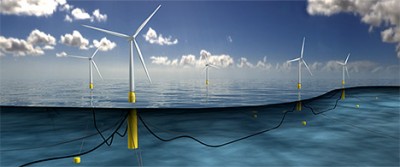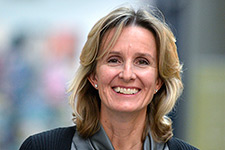Irene Rummelhoff, Statoil’s new top boss in charge of renewable energy, was grinning from ear to ear this week after the company could announce some good news for a change. After months of cutbacks in other areas, Statoil made “the final investment decision” to build the world’s first floating wind farm, and Rummelhoff will be in control.

She said Statoil was “proud” to get the project underway. The goal, she said, “is to demonstrate the feasibility of future commercial, utility-scale floating wind farms.” Rummelhoff said the project, to be located in the windy North Sea about 25 kilometers off the east coast of Scotland, will also increase the global market potential for offshore wind energy.
The project, called the Hywind Pilot Park east of Peterhead in Aberdeenshire, was called “an important step forward” for offshore wind technology and Statoil’s own efforts within renewable energy. It will cover around four square kilometres with windmills placed at a water depth of 95 to 120 meters. Statoil stated that the average wind speed in this area of the North Sea is around 10 meters per second.

Statoil can tap its expertise in offshore installations in building the wind park. Statoil will install a wind turbine farm at the area known as Buchan Deep, which will power around 20,000 households after production of wind energy begins in late 2017. “We are very pleased to develop this project in Scotland, in a region with a huge wind resource and an experienced supply chain from oil and gas,” Rummelhoff said. Scotland’s Deputy First Minister John Swinney called it a “hugely exciting project,” while the British Energy and Climate Change Secretary, Amber Rudd, called it “fantastic news for Scotland and the whole of the UK.”
It’s another breakthrough for the 48-year-old Rummelhoff, who secured Statoil’s first executive vice-president’s post within renewable energy last spring. Before that, she was Statoil’s director of exploration on the Norwegian Continental Shelf and earlier coordinated Statoil’s shale oil investments in the US.

Rummelhoff, who studied civil engineering and petroleum geology at Norway’s prestigious university NTNU in Trondheim, has worked for Statoil for 24 years. She’s also a member of the board at large industrial concern Norsk Hydro.
Newspaper Dagens Næringsliv (DN) has earlier cited Rummelhoff’s “open and disarming style” as “refreshing” in a company where top management is otherwise rather reserved. She’s clearly excited about the prospect for wind energy.
“I think the time is right now,” she told DN in August, a year after oil prices fell dramatically and set off an industry slowdown. “We have seen very positive cost development in wind and solar energy. There’s something happening there now.”
She said at the time that she hadn’t been handed the job to be a climate strategist. “I intend to make a business out of Statoil’s investment,” she told DN. That’s something few have managed before, but Rummelhoff views herself as a businesswoman, not an idealist. Statoil, she said, is investing in renewable energy because of its business prospects, “not because of moral responsibility. We will be realists with an ability to be enthusiastic.”
The diversification comes as Statoil sees its oil fortunes falling, because of lower oil prices, and faces constant pressure on environmental and climate change issues. Industry experts like Ander Bjartnes, editor of Energi og Klima, have called Statoil’s plans for renewable energy development “very sensible” and “positive.” Trond Omdal, an analyst at Pareto, noted the diversification amounted to a “quite limited portion of Statoil’s total market value” but added that Statoil “has ambitions to grow within offshore wind.” Lower costs, demand for green energy and pressure to lessen reliance on oil can help spur growth.
It’s Rummelhoff’s job to make Statoil greener and by 2025, she envisions Statoil as a “relatively large and serious player within offshore wind.” She told DN in August that she hoped Statoil also will have realized “a large-scale project within floating wind.” This week’s announcement confirmed the wind has blown in her direction.
newsinenglish.no/Nina Berglund

